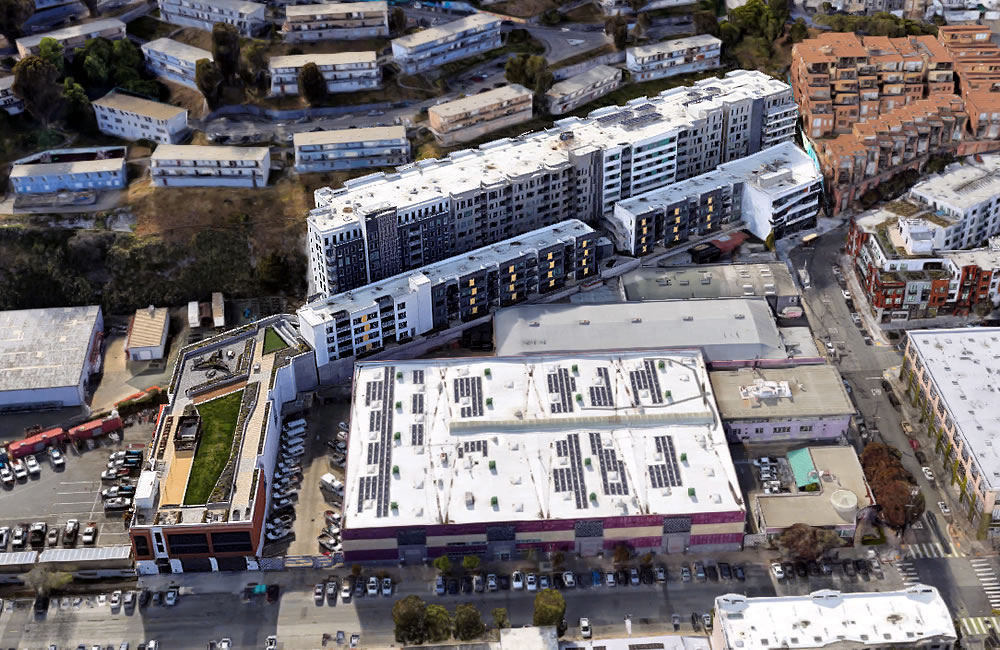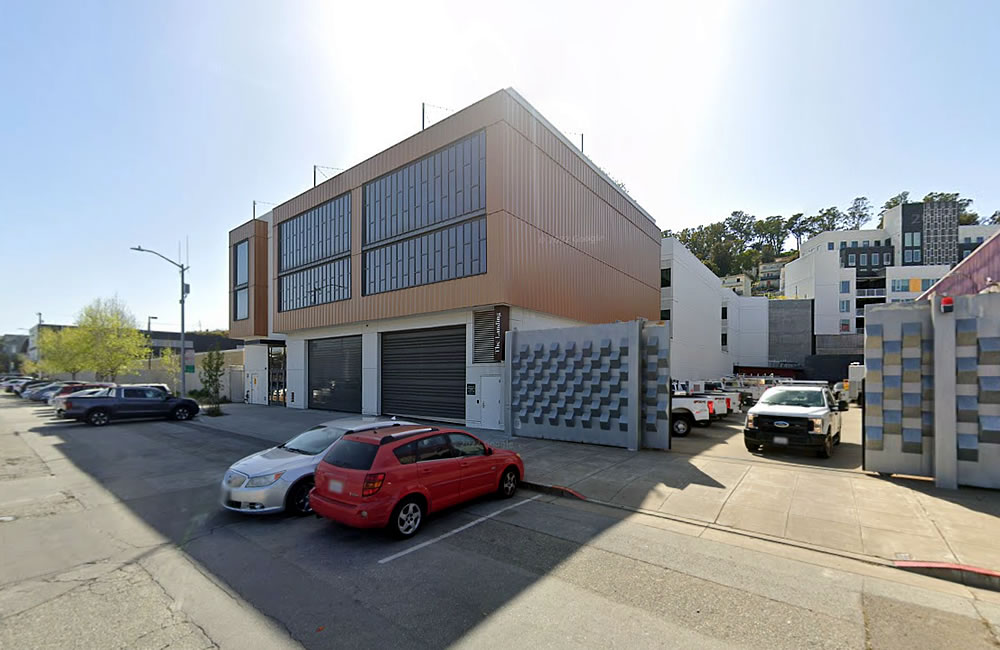Approved back in 2015 and subsequently dubbed “The Landing,” the 257-unit development that rose at 1395 22nd Street, along the East Slope of Potrero Hill, included 47,575 square feet of Production, Distribution, and Repair (“PDR”) space, along with garage access for the Landing’s residents, on the adjacent PDR-zoned parcel at 790 Pennsylvania Street.
Intended to “retain and encourage existing production, distribution, and repair activities and promote new business formation,” acting as “important reservoir[s] of space in San Francisco for new and evolving industry and activity types that cannot be foreseen today and cannot practically function or compete for space in a typical downtown office or neighborhood commercial environment[s],” “free from inherent economic and operational competition and conflicts with housing, large office developments, and large-scale retail,” PDR zoned districts and parcels specifically prohibit residential redevelopment.
That being said, plans to convert the top two levels of the three-story building at 790 Pennsylvania Street into 44 residential units, a mix of 18 studios, 20 one-bedrooms and 6 threes, have been drawn, proposed and are now under review by Planning, a conversion which would require a legislative amendment to rezone the PDR parcel (which is sandwiched between two other parcels which currently prohibit residential uses as well). We’ll keep you posted and plugged-in.


From the landing page for The Landing, final ‘graph: “Pack your bags, see the world, let someone else pay your rent while you’re away with our Airbnb-friendly apartment buildings program. At The Landing you can live in one of San Francisco’s very first Airbnb-Friendly buildings and rent your place up to 90 days per year.”
Don’t see why a legislative amendment to enable such a conversion of the PDR parcel to residential in order to support more gig-economy “superhosts” would be adopted at a time when the Board of Supervisors have been falling all over themselves passing legislation to enable conversion of downtown office space to residential and few such conversions have been proposed.
They are barking up the wrong tree now. If they want to do some conversion, they should find a suitable empty office building downtown and convert that to new units to feed the AirBnB beast.
It’s outright class war. The easily-sidestepped PDR Maginot Line bandaid in the eastern neighborhoods has been a trivial obstacle for the Banker-Builder-Landlord-Agent Wermacht..
The City’s short-term rental rules should still apply limiting short-term rentals to 90 days per year. This building simply allows tenants to short-term rent their units while on vacation. I doubt that “super hosts” would be willing to rent a unit in the building assuming it would sit vacant for 270 days per year.
As a renter myself, I would love to be able to Airbnb my unit, but my landlord won’t allow it. Currently, property owners end up being the sole beneficiaries of the Airbnb economy meaning they can afford to subsidize their month in Mexico while most renters cannot.
Even if skeptics of “the Airbnb economy” and those convinced of it’s negative impact on the local rental market conceded all of that, it’s beside the point, which is: the city shouldn’t pass a legislative amendment to rezone this PDR parcel and hand a sweetheart deal to the operators of The Landing just so AirBnB can feature more units on it’s “platform”. There are already plenty of San Francisco units on AirBnB/VRBO. There are also plenty of other places in the city amenable to creating new AirBnB units. There are a shrinking number of places for Production, Distribution, and Repair.
So it is preferable to choose the future’s “new and evolving industry and activity types that cannot be foreseen today” over today’s housing shortage? Given this location’s super-prime transit location, and the fact that many residential projects are no longer penciling, it seems reasonable to allow it. Although I admit I have trouble understanding zoning this location PDR in the first place…
Also how is a house that can’t be rented 275 days a year an “AirBnB unit”? Brahma, if there were no short-term rentals allowed would you be for the project?
“Although I admit I have trouble understanding zoning this location PDR in the first place”
AYFKM? Dogpatch was a longtime light industrial neighborhood before the gentrification spawned of waves of real estate bubbles wiped out good jobs for local, often non-white people without graduate degrees. Lowlifes with neither skills in symbol manipulation nor connections to upper social strata clearly don’t deserve good jobs , so f— ’em, right?
The war on the working classes, essential workers, poor people, and otherwise economically marginalized people never sleeps. The top-down, unilateral class war is so pervasive and internalized, that most people don’t even notice it.
One’s rant aside, this location is barely (as in, “not”) in the Dogpatch. Forgive me if that was not the case before “the new freeway”!
Light industry has been fleeing cities all over the world. It’s the same in Seattle, New York, Paris, Boston, London, Toronto.
SFRealist: Yes, class war and real estate speculation are known to occur elsewhere.
Commenter: Whatever the property sales agent brochures or neighborhood association maps may say, the industrial stretch below the east side of Pot Hill was called Dogpatch long before the freeway arrived to provide a convenient marketing demarcation. Whether the stub west of the freeway below the projects is considered Pot Hill or Dogpatch makes absolutely no difference to my argument, but you’re welcome to be a miereneuker, as the Dutch would say.
Is it class warfare or is is just how things change?
There used to be a 1000 foot long building in the Dogpatch for making rope. That building is no longer there. Is it because of class warfare, or is it because that we don’t have sailing ships anymore that use rope?
Anyone who has been even a short-term renter and has personally been in the presence of an S.F. mom-and-pop landlord as they thunder “I am an OWNER! No one is going to tell me what I can and can’t do with my property!” with a little bit of spittle coming out of the corner of their mouths understands that just because The City has rules in place limiting short-term rentals to 90 days per year doesn’t mean homes won’t be short-term rented during the remaining 275 days a year.
Local landlords can and do put their units on AirBnB for longer than that, and if they think they are going to get caught, they just advertise them on craigslist illegally. And then they post to this site saying that the only way they can be stopped is if S.F. gets rid of rent control so they can charge market rate for units they acquired at prices that reflect the returns available under rent control.
Where does it say these units will be AirBNB? If they are straight up rentals, then everyone is okay with it? I dont think adding housing stock, in whatever form it takes, is a bad thing. Take a look around at how many PDR zoned spaces are actually occupied….like 0.
I would be curious to see a comparison of pdr vacancy vs residential vacancies and a comparison of businesses unable to find pdr leases and number of homeless. You’d think looking at that data it’d be easy to make an informed decision.
Also, if San Francisco wants to have PDR businesses, there are about 500 no-brainer changes to local laws and regulations that would be more effective than arbitrarily increasing supply of the buildings.